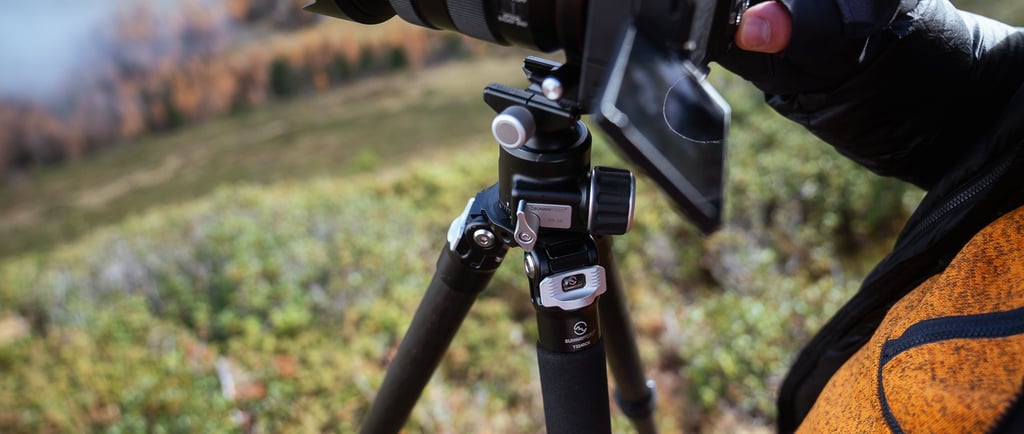Choosing the right tripod
A detailed guide on how to pick the perfect tripod for landscape photography


How to Choose the Perfect Tripod for Landscape Photography
As a landscape photographer, choosing the right tripod can be more challenging than you might expect. We need something sturdy and durable to handle rough weather and uneven terrain, but at the same time, we want it to be lightweight and easy to carry. In this article, I'll share my experience with tripods and explain why I believe the one I use has the best form factor for landscape photography.
My Search for the Ideal Tripod
Over the past few years, I’ve spent a lot of time (and money!) searching for the perfect tripod. I’ve tested different models, sizes, and even managed to break a few along the way. But in the end, I finally settled on one that meets all my needs.
Quick disclaimer: The tripod I use was sent to me by Sunwayfoto, but this is not a sponsored review. They don’t get to see this article before I publish it, and my focus here is on design and functionality rather than just the brand. If you like this tripod, you’ll find a link at the bottom of the article where you can get a small discount while also supporting my work.
Key Features to Consider
1. Feet and Stability
A good tripod should provide solid grip on different surfaces. Rubber feet are the best all-around option, offering stability on most terrains—except ice. That’s where steel spikes come in handy, and many tripods, including mine, come with interchangeable feet.
One small downside I’ve noticed with my tripod is that the rubber feet can loosen over time. I’ve never actually lost one, but it’s a good idea to check and tighten them occasionally.
2. Carbon Fiber Legs
For landscape photography, carbon fiber is the best choice for tripod legs. It’s lighter, more flexible (which helps absorb vibrations), and doesn’t feel as cold to the touch in low temperatures compared to aluminum.
3. Locking Mechanism: Twist Locks vs. Lever Locks
The choice between twist locks and lever locks comes down to personal preference. I personally prefer twist locks—they’re simple, quick, and easy to use, even with thick gloves. Lever locks, on the other hand, tend to be more fragile and can easily get caught on your backpack straps.
4. Low-Profile Shoulder Design
My tripod has a very narrow shoulder, making it a low-profile model when folded. This is a great feature for hiking since it keeps the weight closer to your body, improving balance. If you don’t hike much, you might prefer a wider version for added stability.
5. Avoid Center Columns
I never recommend tripods with a center column. Here’s why:
It adds vibrations and reduces stability, which is the last thing you want in windy outdoor conditions.
It increases weight unnecessarily.
It limits how low you can position your camera. Getting close to the ground is often essential for capturing strong foregrounds or maintaining stability in harsh conditions.
If you need more height, you probably just need a taller tripod rather than a center column.
6. Choosing the Right Tripod Head
For landscape photography, a ball head is the best choice. Here’s why:
It’s faster to adjust compared to a geared or two-way head. Sometimes, the best light lasts only a few minutes—or even seconds—so being able to set up quickly is crucial.
Geared heads have more knobs to adjust and require your tripod to be perfectly level; otherwise, your composition will be off.
A ball head allows for quick, one-handed adjustments, even if your tripod isn’t perfectly level.
7. Size and Height Considerations
Sunwayfoto, like many brands, offers different sizes for the same tripod design, varying in tube diameter and overall height. I personally use a 32mm diameter model—it’s sturdy yet light enough for me.
When choosing a tripod, consider your specific needs:
If you’re a hiker or use a lightweight camera, a smaller, lighter option will suffice.
If you have heavier gear and prioritize stability, opt for a sturdier model.
Always choose a tripod slightly taller than you think you need. On uneven terrain or slopes, extra height allows for more flexibility in composition without compromising your comfort.
Final Thoughts
There’s no one-size-fits-all tripod—it all comes down to your needs, shooting style, and gear. However, investing in a solid, well-built tripod that suits your workflow will serve you for years and make a significant difference in your photography.
What tripod are you currently using, and are you happy with it? Let me know in the comments! And if you're looking for more tips on landscape photography, stay tuned for future articles.